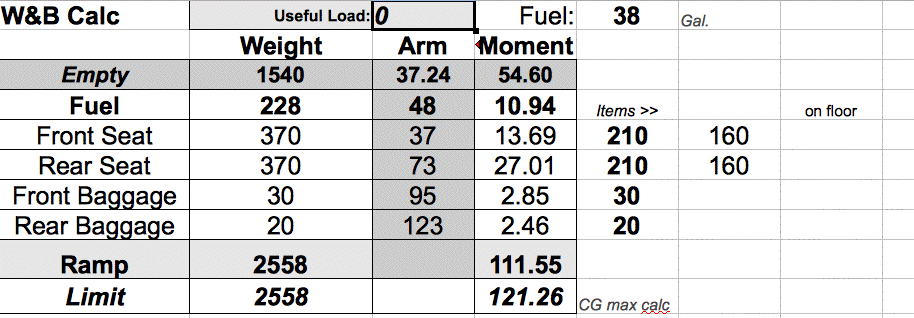JohnSBA
Pre-takeoff checklist
I've been working on a W/B spreadsheet for my 172Q that will calculate CG aft limit for the gross weight it calculates from my loading inputs. I'd looked for something online, and after a few minutes of searching decided to do my own. The sheet I have so far needs to be validated, and I need to add the Arm calculations at the bottom of that column. Once I feel comfortable that the sheet works as intended I'll try to figure out a way to share it here in case it's of use to anyone else doing their own and capable of checking/modifying my formulae.
Since the Aft CG limit line on the 172 chart is straight I just used a constant calculated from the top & bottom values of the line. That way you get the Moment limit number for the calculated weight, that you can compare with the calculated CG Moment of your loading. So for other types of a/c you'd need to change the baseline numbers and presumably also the constant, but then you'd have a sheet you can use on the Droid X or any other such device (Android, iPhone, iPad, Blackberry, etc...).
So far, as described in an Android POA thread, I'm using the free Shead Spreet Lite as my app for this on my cool $50 Droid X, but will be looking into other spreadsheet app options. Meanwhile, here's what the spreadsheet looks like on the computer:

I haven't yet locked the calculated cells, or messed with the cell background colors to draw the eye toward input points. I find it really useful being able to quickly run different loading scenarios, to get the remaining useful load number I'm after.
All this is leading up to figuring out the optimal CG for my plane. My current idea is to fly with my wife in the back seat and have her gradually pull a 20# weight (soft camp-style water jug?) forward as I adjust trim and check stable airspeed. Has anyone figured out a better way to do this? Once I know the optimal CG Arm number, I can aim for that with the spreadsheet.
Since the Aft CG limit line on the 172 chart is straight I just used a constant calculated from the top & bottom values of the line. That way you get the Moment limit number for the calculated weight, that you can compare with the calculated CG Moment of your loading. So for other types of a/c you'd need to change the baseline numbers and presumably also the constant, but then you'd have a sheet you can use on the Droid X or any other such device (Android, iPhone, iPad, Blackberry, etc...).
So far, as described in an Android POA thread, I'm using the free Shead Spreet Lite as my app for this on my cool $50 Droid X, but will be looking into other spreadsheet app options. Meanwhile, here's what the spreadsheet looks like on the computer:

I haven't yet locked the calculated cells, or messed with the cell background colors to draw the eye toward input points. I find it really useful being able to quickly run different loading scenarios, to get the remaining useful load number I'm after.
All this is leading up to figuring out the optimal CG for my plane. My current idea is to fly with my wife in the back seat and have her gradually pull a 20# weight (soft camp-style water jug?) forward as I adjust trim and check stable airspeed. Has anyone figured out a better way to do this? Once I know the optimal CG Arm number, I can aim for that with the spreadsheet.



